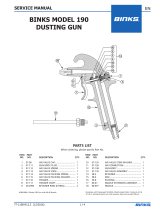
77-2475-R5.2 (9/2017)4 / 12
EN
www.carlisleft.com
OPERATION:
To introduce roving to the cutter, dou-
ble over one end of roving and insert it
through one of the three holes in the
feed bar (18) on the top of the cutter
assembly. The air motor control knob,
on the front of the manifold (6), should
be opened three or four turns, and the
blower control knob, on the rear should
be opened a 1/4 turn. Pull the trigger
and the glass will be dispensed into the
resin stream. By opening or closing the
blower control knob, the glass pattern
will vary in width. By opening the
motor control knob, glass content will
be increased. Close this knob and glass
content will be decreased. Adjust both
motor control and blower control to
produce the desired output and pattern.
The resin fan should be approximately
3" wider than the glass pattern. This
allows the fan pattern to pre-wet the
part and post wet the glass.
ADJUSTMENTS:
Cutting head (11): It should have
sufficient tension against the anvil
sleeve (17) to cut properly. Excessive
tension will overload the air motor
(5) and create starting problems.
Insufficient tension will not allow
complete cutting of the roving. The
eccentric nuts (4) can be used to
adjust the tension correctly.
Idler bearing (16): This should be
adjusted to have a slight contact with
the anvil sleeve (17). Excessive con-
tact will create starting problems.
Insufficient contact will not allow
the roving to feed correctly. The
eccentric nut (4) on the end of idler
bearing is used to adjust the idler
bearing to the correct tension.
Air motor oiling (5): This is accom-
plished by removing the motor con-
trol knob from the manifold assembly
(6), and inserting 2 to 3 drops of light
weight machine oil (use Binks 207-
11155-1). Replace the control knob
and the cutter guard, and run for a
few seconds, wipe off any excess oil.
(Or oil may be added to an in-line
oiler on the air supply hose.)
Cutter alignment: The roving
should enter the resin fan as soon
as possible without excessive fall
out. Simply push the cutter forward
or pull back to achieve this. To
adjust the cutter angle from side to
side, simply turn the knob (22g) on
the mounting bracket (22) in the
direction desired.
DISSASSEMBLY:
1. Start by removing the cutter guard
assembly (14) and chute (13).
2. To remove the air motor assembly
(5) and manifold assembly (6) first
remove the outer retaining ring
(5b) and the anvil sleeve (17) from
the air motor assembly.
3. Then loosen the Allen head cap
screw (2), releasing the air motor
assembly and the manifold assem-
bly from the back plate (1).
4. If it is stuck, you may need to use
slight pressure from a screwdriver
between the air motor and back
plate to free it.
5. To remove the manifold assembly
(6), remove the air hose (25), valve
and elbow (21, 23), and the modi-
fied head screw (7) from within the
manifold. The manifold assembly
will then drop free of the air motor,
and expose the three o-rings (6f).
6. Inspect the muffler (6a) and the
blower tube (6c) for any wear.
Replace if necessary. Be sure to
insert so that the blower holes are
pointing in the right direction.
7. To remove the control knobs from
the manifold assembly, remove
the thumbscrew (6k). Then use a
screwdriver to remove the packing
nut (6i) and the o-rings (6g, 6h).
Replace the o-rings if necessary.
Repeat for other side.
8. For disassembling the air motor
assembly (5), begin by removing
the two pins (5d) holding the tire
shaft (5c) to the rotor. Next pull
the tire off the shaft. Refer to Part
Sheet 77-2883 for further details.
9. Check the bearings (5e) for any
wear, replace if necessary.
10. To remove the cutting head
assembly (11) from the back
plate, hold the eccentric nut (4)
and unscrew the cutting head
bolt (12). To remove the cutting
blades (11f), use a small screw-
driver to pry out the blade spacer
(11e), and the retaining spring
(11d). The old blade will fall free
of the slot when this is done.
11. To remove the cutter bearing
(16) from the back plate, hold
the eccentric nut (4) and unscrew
the hex head screw (15).
RE-ASSEMBLY:
Manifold Assembly:
1. Lubricate the o-rings (6g, 6h) with
petroleum jelly and insert into the
manifold body (6e).
2. Next thread the packing nut (6i)
into the manifold body.
3. Then thread the lock nut (6j) onto
the thumbscrew (6k) and insert
into the manifold body.
4. Repeat steps 1-3 for the other side
of the manifold.
5. Now thread the jam nut (6d) onto
the blower tube (6c). And then
thread the blower tube into the
manifold body. Be sure to note
the position of the blower tube
holes when inserting into the
manifold body.
6. Finally thread the muffler (6a) into
the muffler adapter (6b) and insert
them into the manifold body.
Binks MODEL 201-510 ROVING CUTTER
NOTE
Lubrication is very important and the
motor should be oiled after every 2-4
hours of continuous use.
CAUTION
DO NOT USE A HAMMER TO FORCE
THE AIR MOTOR OUT.
!




















